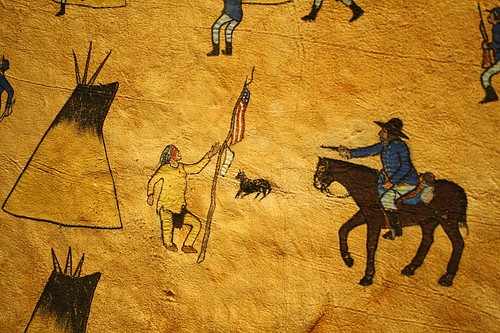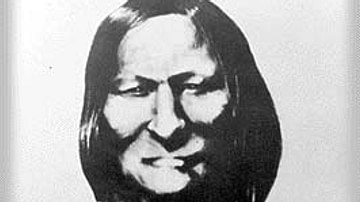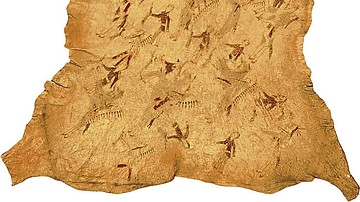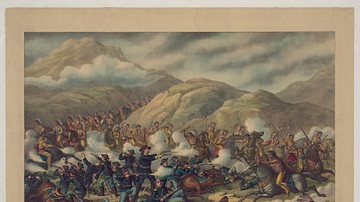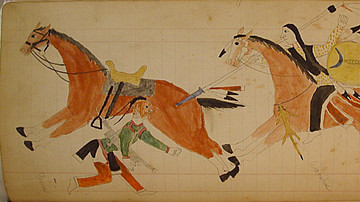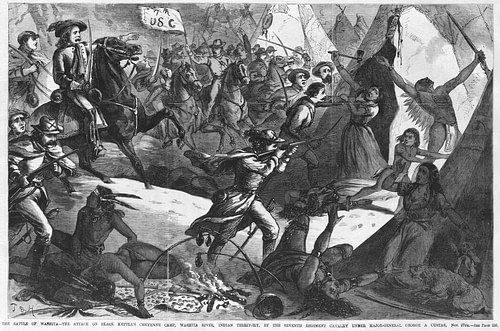
The Washita Massacre (Battle of Washita River) was the slaughter of the village of the Southern Cheyenne Chief Black Kettle (l. c. 1803-1868) and the peace chiefs aligned with him on 27 November 1868 at the hands of the 7th Cavalry led by Lt. Colonel George Armstrong Custer (l. 1839-1876), even though they had been promised protection.
Black Kettle had been seeking peace with the Euro-American invaders since 1851 and had signed every treaty presented to him and the other peace chiefs – those who sought to live amicably with the settlers – from then up through 1868. On 29 November 1864, while living under what he understood as the protection of the United States government, Black Kettle's village was attacked and destroyed in the Sand Creek Massacre orchestrated by Colonel John Chivington (l. 1821-1894), leading the Third Colorado Cavalry. Black Kettle survived that onslaught but was killed, along with his wife and between 60-150 other Cheyenne and Arapaho, at the Washita Massacre in present-day western Oklahoma.
The conflict was initially reported as a glorious victory for Custer, already a famous war hero from his service in the Union army during the Civil War, over hostile Indians who had been preying on innocent settlers. Shortly after the event, however, eyewitness accounts challenged that narrative, and Custer was, rightly, accused of murdering peaceful Native Americans, mostly women, children, the elderly, and the injured, who had nothing to do with the raids on Euro-American settlements.
Background
Conflicts between Euro-American settlers and the Plains Indians were already an issue by 1823, but tensions increased in the following years as more people moved west. In 1845, journalist John L. O'Sullivan (l. 1813-1895) coined the term "Manifest Destiny" in arguing for the annexation of Texas and Oregon territories to the United States, claiming that the US was "divinely appointed" to establish itself across North America. Although this concept had appeared earlier with different phrasing, it became especially popular in the mid-19th century. The only obstacle to making the destiny of the United States manifest were the people who had lived on the land for thousands of years.
In an effort to control the nomadic and semi-nomadic Native peoples of North America and prevent further conflict, the Fort Laramie Treaty of 1851 was signed between US officials and the Arapaho, Cheyenne, Crow, Sioux, and other nations, recognizing the legitimacy of Native American occupancy of 'Indian Territory' as distinct from lands available for US settlement, among other terms.
Black Kettle signed the treaty, along with other peace chiefs, as he understood that continued conflict was no good for either side. However, there was no way the representatives of the nations that signed that treaty could force other chiefs, who had not signed, to comply with it. The US officials repeatedly made the mistake of assuming the chief of one band was the leader of the entire nation, and so conflict continued, as in the case of the Grattan Fight (Grattan Massacre) of 1854 in which 2nd Lt. John Grattan's command attacked a Sioux village and was wiped out.
The treaty of 1851 was never actually honored by the United States and was abandoned in 1858 when gold was discovered in the region, prompting the Pike's Peak Gold Rush and an influx of even more settlers. Further conflicts led to the Treaty of Fort Wise in 1861, also signed by Black Kettle, which was also ignored by US settlers and authorities. Although Black Kettle continued to advocate for peace, other Cheyenne chiefs, including Chief Tall Bull and Roman Nose (Cheyenne Warrior) continued to defend their land through military actions and raids on settlements and wagon trains.
The Colorado War (1864-1865) was a response to the failure of the US government to honor their treaties, and tensions only escalated after the Sand Creek Massacre on 29 November 1864 when Black Kettle's camp, flying the American flag and the white flag of truce, was attacked by Colonel John Chivington, resulting in over 150 Arapaho and Cheyenne casualties, mostly women, children, and the elderly, as most of the young men were away hunting.
Red Cloud's War (1866-1868) was launched by the Lakota Sioux chief Red Cloud (l. 1822-1909) in another attempt to stop westward expansion and force the United States to honor its treaties. This conflict was allegedly resolved by the Fort Laramie Treaty of 1868, which established the Great Sioux Reservation while, at the same time, the Cheyenne, Arapaho – and any others who wanted to – were promised protection by the United States if they would move to designated locations where they would be recognized as "friendly Indians" and receive regular provisions and supplies.
Sheridan & Custer's Total War
Cheyenne, Arapaho, and other war parties were still making raids on settlements and attacking wagon trains, however, as these promised supplies never materialized. General Philip Sheridan (l. 1831-1888), tasked with bringing the region under control, decided on a policy of total war, which entailed killing all warriors, hanging all men taken prisoner, capturing women and children to use as hostages, destroying all Native American villages, horses, ponies, food supplies, and, further, attacking Native American camps in winter, when military campaigns were usually suspended. Scholar Nathaniel Philbrick writes:
Sheridan wanted to try a new strategy against the Cheyenne. Instead of chasing them around the plains in summer, why not strike them in winter, when they were confined to their teepees...Sheridan [was] convinced it would work – especially if the operation was led by Custer, one of the most indefatigable and courageous officers he'd ever known.
(11)
Sheridan and Custer were both well-known heroes of the American Civil War (1861-1865) on the Union side and Custer had then served with Major General Winfield Scott Hancock (l. 1824-1886) during Hancock's War against the Cheyenne in 1867. During that campaign, Hancock had surrounded a Cheyenne village at Pawnee Fork, but, when the attack was launched, there was no one there to fight; all the villagers had managed to slip away. Hancock ordered the village burned, along with all the people's possessions and food supplies, but it was hardly a victory and served as a lesson for Custer when he agreed to implement Sheridan's plan and attack villages in winter.
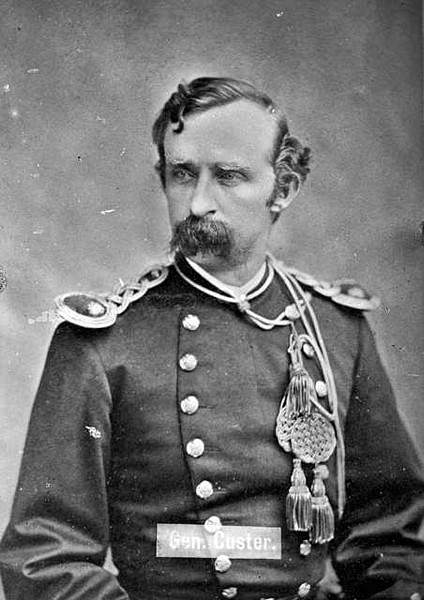
The Winter Encampments
On 20 November 1868, Black Kettle and his fellow chief Little Rock (l. c. 1805-1868) met with Major General William B. Hazen (l. 1830-1887) requesting sanctuary near Fort Cobb. Along with chiefs Big Mouth and Spotted Wolf of the Arapaho, Black Kettle told Hazen they wanted to live in peace but were continually harassed by US soldiers. If they could move closer to Fort Cobb, they felt, they would be safer and could also better maintain control over the young warriors in their bands who kept joining war parties. Hazen, before the meeting even started, knew he could not grant their request because Sheridan had designated the Arapaho and Cheyenne as 'hostiles', and so he sent them back to their camps.
The winter camps of the Arapaho, Cheyenne, Comanche, and Kiowa were spread along approximately 15 miles (24 km) of the Washita River, also known as the Lodgepole River, with Black Kettle's village furthest west and distanced from the others. There were an estimated 6,000 people in the winter camps and, as Black Kettle's was at the far end of the line, anyone returning to their camp from the west would pass through or near his village to reach their own downriver. Black Kettle and the others left Fort Cobb on 21 November and arrived at his village toward evening on the 26th, and, that same day, a band of Kiowa, returning from a raid on the Utes, passed through his village on the way to their own.
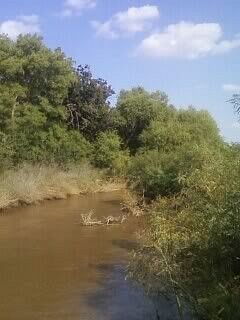
Washita Massacre
Custer, meanwhile, was leading his men of the 7th Cavalry through bitterly cold weather, in heavy snow, searching for signs of trails to a hostile Indian camp. On the night of the 26th, such a trail was found by Major Joel Elliot (l. 1840-1868) and Custer's Osage scouts. The Osage noted that the tracks only suggested horses and men, and so was no doubt a raiding party, as a hunting party would have had dogs and women along. Custer followed the trail until he smelled campfire smoke and arrived at a bluff overlooking Black Kettle's village. The camps of the others downstream were not visible. Philbrick writes:
Custer and his officers observed the village from one of the surrounding hills. The tepees were clustered on a flat thirty-acre crescent just to the south of the Washita River. One of his officers asked, "General, suppose we find more Indians there than we can handle?" Custer was dismissive. "All I am afraid of is we won't find half enough."
(134)
Not wanting to make the same mistake as Hancock at Pawnee Fork, Custer divided his command into four battalions, Captain Frederick Benteen (l. 1834-1898) would attack from the west, Elliot from the northeast, Captain William Thompson from the south, and the village would be covered by sharpshooters under Lt. Cook to the north; Custer would sound the attack and lead his own contingent. Just after dawn, he heard a single shot ring out from the camp, ordered the charge, and commanded the band to start playing the 7th cavalry's song, "Gary Owen" as he galloped toward the village.
The gunshot had come from Double Wolf, a member of Black Kettle's band, who had seen the soldiers moving into position and fired to warn the village. He was almost instantly killed as Custer and his men rode in. Little Rock tried to form a defense to allow the women and children to escape and held the line until he and the others were killed. Black Kettle and his wife Medicine Woman were shot in the back crossing the river and killed. Most of the casualties fell within 15 minutes of Custer sounding the charge.
Benteen focused on capturing women and children to be held as hostages, but many of these were being shot down by others before they could be caught. Custer, when he heard of this, ordered women and children spared and taken prisoner, but many were already dead. Major Elliot broke from the main force to run down villagers who had managed to escape. He was cut off and killed along with the 17 soldiers who had followed him.
The soldiers took 53 Cheyenne and Arapaho women and children prisoner and burned the village. Custer then ordered all the horses and ponies killed – estimated at either 675 or 875 – before he was alerted to fully armed warriors appearing on the far hills. Custer had no knowledge of the other villages beyond Black Kettle's but, taking the offensive, marched in their direction with his hostages in full view. When the warriors retreated from their positions, because they did not want to hit the hostages with arrows meant for soldiers, Custer wheeled about and marched his columns back to his post at Camp Supply (later known as Fort Supply). The next morning, he sent his report to Sheridan, claiming he had killed 103 warriors, destroyed 875 ponies, captured 53 women and children, and left the village in ruin. He had lost two officers – Major Elliot and Captain Louis McLane Hamilton (grandson of Alexander Hamilton) – and 19 enlisted men, with another 13 wounded in action.
Aftermath & Response
The first newspaper accounts of the Battle of the Washita were based on Sheridan's report of 29 November, which was published in the Daily National Intelligencer. In early December, other newspapers were printing the same story of a great victory over a large band of 'hostile Indians' and the gallant risks and sacrifices of the 7th Cavalry. On 12 December, Colonel Edward W. Wynkoop (l. 1836-1891) who, as a major had investigated the Sand Creek Massacre and was sympathetic to the Cheyenne, resigned his commission over what he called a massacre of innocents who had sought the protection of the United States and been betrayed. Philbrick comments:
Both Custer and Sheridan heralded the Battle of the Washita as a great victory, claiming that Custer had killed more than a hundred warriors and almost eight hundred ponies and destroyed large quantities of food and clothing. But, as a local Indian Agent pointed out, the leader of the village had been Black Kettle, a noted "peace chief" who had moved his people away from the larger village so as not to be associated with the depredations of the villages' warriors. Instead of striking a blow against the hostiles, Custer had unwittingly killed one of the few Cheyenne leaders who were for peace.
(12)
Sheridan responded to the criticism by claiming Arapaho and Cheyenne raiding parties had been operating in the area out of Black Kettle's camp and that items stolen from White settlers' homes were found by Custer in the camp on the morning of the attack. No mention of such items appears in Custer's report, and, in fact, there was no search for any such contraband or even an official tally of the dead. According to eyewitness accounts, Custer only made the tally he sent to Sheridan two nights after the battle based on what his officers remembered seeing on the field and figured the dead probably numbered around 103.
On New Year's Day 1869, Major General Hazen, who was not fond of Custer, published a letter from a White woman, Mrs. Blinn, held hostage in Black Kettle's camp, whom he had been working to have released. Her body was found among those killed in the Washita Massacre and it was clearly from friendly fire. As more details of the morning of 27 November 1868 emerged, newspapers were reporting the event as a "massacre" and senators were calling for an investigation. On 8 February 1869, an anonymous letter published in the Missouri Democrat characterized the 'battle' as a massacre and Custer as a bloodthirsty lunatic who shot women and children and left 18 of his men, including Major Elliot, on the field unaccounted for.
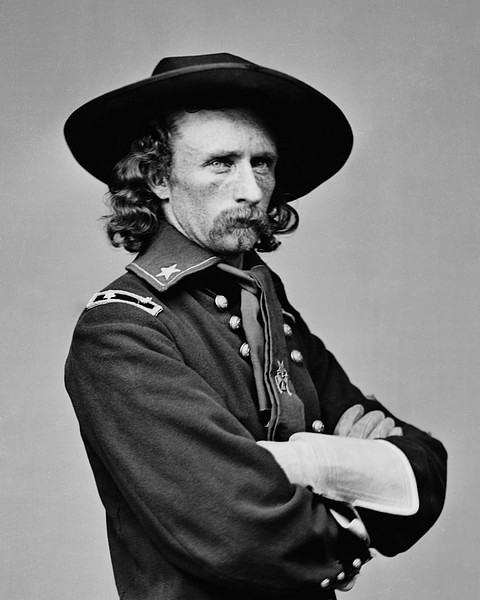
The bodies of Major Elliot and the 17 men who had accompanied him were found stripped and mutilated a few miles from Black Kettle's camp when Custer and Sheridan returned in December. It was at this time that the number of Native American casualties was raised to 140 or 150. Whoever had written the letter was aware that Elliot had broken with the main body of troops on 27 November and claimed that, even though Custer knew the major had not reported in, did nothing to discover his whereabouts or ascertain his safety. The anonymous author would eventually be identified as Captain Benteen, a close friend of Major Elliot, and the animosity between Benteen and Custer would continue until the Battle of the Little Bighorn in 1876.
Conclusion
There never was a Congressional investigation into the events of 27 November 1868, but the question of whether it had been a battle or a massacre was fought out in the press. It was later reported that the women taken captive had been 'used' by the officers of the 7th Cavalry on their way back to Camp Supply and that Custer had taken one of them – Monahsetah (l. c. 1850-1922) – daughter of Chief Little Rock, as his mistress.
Custer denied the claims that he had massacred anyone on 27 November, noting that a 'massacre' would have entailed killing everyone in the village – which had clearly not happened since he had taken 53 women and children captive. To restore his reputation with the press, he embraced a policy of diplomacy with the Arapaho and Cheyenne, negotiating with them for the return of White settlers held hostage in exchange for those he had taken from Black Kettle's camp.
The question of whether the Washita conflict was a battle or a massacre continues in the present day. The area where the conflict took place is now the Washita Battlefield National Historic Site outside of Cheyenne, Oklahoma. The Cheyenne and Arapaho nations, who have always recognized the event as a massacre, continue to lobby for the name of the historic site to be changed as it was never a 'battlefield' as that term is usually understood. They also continue to hold the 27th of November as a day of remembrance and tie prayer cloths to the trees along the river in honor of those who fell in the Washita Massacre.
